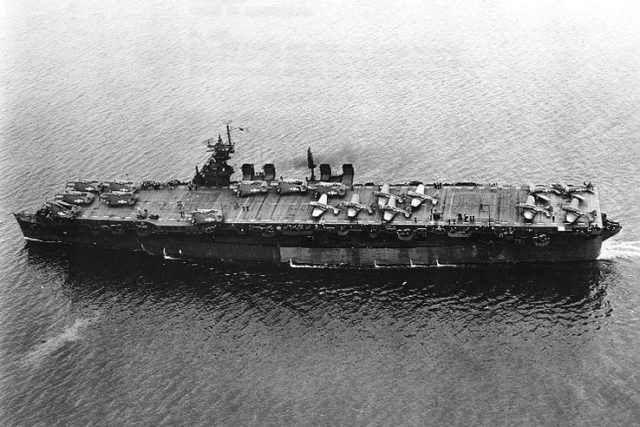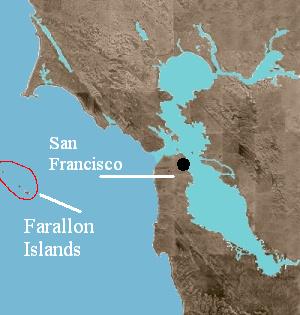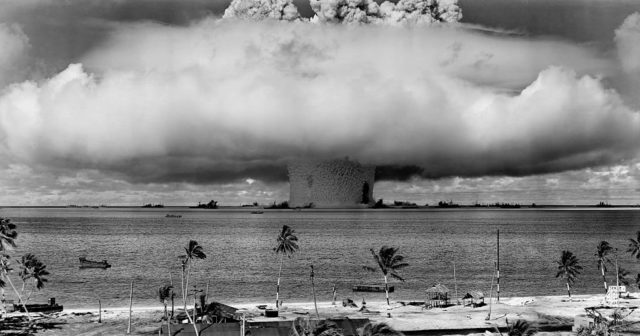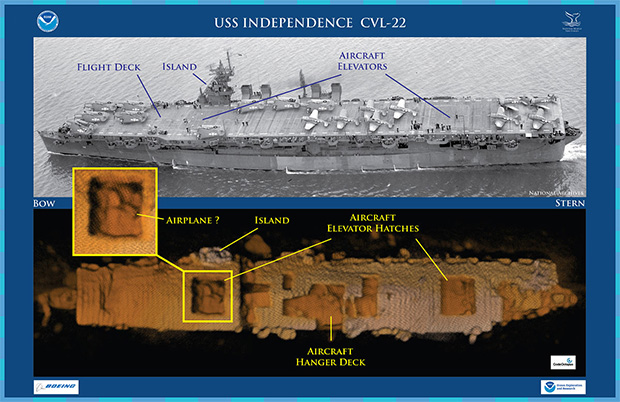Around 60 years ago an aircraft carrier was blown up by two atomic blasts. It then later sunk off the coast of California. Finally, the wreckage of the historic USS Independence has been sighted for the first time.
It was found in April of this year. The Ocean Exploration Trust (OET) has explored the wreck with robotic submarines, and they have released the first close-up pictures of how the ship looks currently.

This exploration is unveiling what war secrets the ship holds, including a fighter plane inside the sunken aircraft carrier.
The USS Independence operated in the western and central Pacific from November 1943 until August of 1945.
It was surveyed by a team of researchers that was guided by James Delgado from the Maritime Heritage at the NOAA in April of last year.
The ship was a part of the carrier group that took part in the Battle of Leyte Gulf, and was assigned to to strike against targets in Japan and the Philippines.
It was later when one of more than 90 vessels were assembled to target the fleet for the Bikini Atoll atomic bomb tests in 1946.
After being conveyed back to San Francisco and Pearl Harbor for study, the vessel later had been sunk close to the Frallon Islands on January 26, 1961. It had been loaded with 55-gallon drums of low-level radioactive waste.

This year, the wreckage was discovered in 792 meters (2,600 ft) of water. It was off the coast of California’s Farallon Islands and was said to be astonishing intact, with the hull and flight deck still clearly visible. There appears to be a plane located in the carrier’s hangar bay.
The scientists had known where to look since the ship was sunk intentionally in 1951.
The science team that was on board as well noticed that the bow had struck the seabed first, burying itself inside of the sediment regardless of having started to sink stern first. The team as well discovered two aircraft.
To be able to study the wreckage, the team of technicians and scientists on board of the sanctuary vessel R/V Fulmar used a 5.6 meter (18.5 ft) long autonomous under water vehicle. It was called the Echo Ranger from The Boeing Company.
The damage that was surveyed was a mix of damage sustained in the atomic bomb blasts of 1946 as well as damage from when she had made the impact with the bottom of the ocean. There was general corrosive wear from many years of being in the seafloor.
They confirmed the presence of the wrecked aircraft F6F-5N Hellcat still in one of its hangers. They later in the dive discovered the remnants of a second aircraft.

The ship had fought a long, hard war in the Pacific. After the war, it was subjected to two atomic blasts that tore through the ship. This is a reminder of the industrial might and the skill of the greatest generation. It did not just send this ship to war but their loved ones as well.
The 40mm anti-aircraft weaponry was surrounded by massive glass sponges. There are 300 estimated wrecks in the waters off San Francisco. The deepest noted shipwreck is in the sanctuary.
Divers are not able to pick up the equipment with the crash because the materials are contaminated from radiation. Though underwater radiation only extends out several inches, water is an excellent radiation shield. The submarine stayed at least 30 meters (100 ft) away from the wreck.
With the radioactive past, the marine archaeologists had a concern about how safe it would be explore the wreckage. Contaminated rust particles are released from the ship and transported by the water. The dilution factor of the ocean is very large; it essentially nulls any radioactive effects.
While a relatively small number of organisms near the wreck might take up some of the rust particles, but the effects of the radioactivity are diluted through the food chain because the number of organisms that are exposed are so tiny.
In contrast, mercury is much more prevalent and very widely distributed throughout the ocean. This is the reason why the concentration builds up in the food chain. The isotopes of concern, in this case, cesium 137 and strontium 90, both have a half-life of about 30 years.
This would mean that after 30 years, half of the isotopes that are responsible for the contamination will transform into non-radioactive isotopes. It has been around 60 years since the USS Independence was sunk, so less than a quarter of the first radioactive isotopes remain.
The blast gauge tower is recognized as a “Christmas Tree” that served as a mount for the pressure measurement gauges that were used in the atomic testing.
Throughout the test, the ship had been damaged by heat and radiation and shock waves. Yet it some how manged to survive and return to Half Moon Bay. California was used as the port of operations for the Independence survey mission.
The very first multi-beam sonar survey for the Independence site was done by the NOAA ship Okeanoes Explorer in the year of 2009.
To demonstrate his discovery, Professor Vetter took a squad of researchers and students to the harbor of Half Moon Bay. He wanted to test the submersible after sonar images were captured of the aircraft carrier. He had used instruments that were called dosimeters. These were used to pick up the ionizing radiation, but they found no proof of contamination on the submersible.
The two tests, known as Operation Crossroads, were done in the immediate aftermath of the atomic end of WWII in Japan. This had signaled a new era in world history.
After WWII, the United States conducted the first nuclear test on July 1st, 1946. This explosion took place at the Bikini Atoll lagoon in the Marshall Islands of the Pacific Ocean.
The fission bomb explosion was very identical to the weapon they had used in the attack on Nagasaki on August 9th, 1945. This had occurred 158 meters (518ft) above seal level. The explosion had a yield of 23 kilotons.
The bomb had been named Gilda after the Rita Hayworth character in the 1946 film.

The main aim was to test the effects of nuclear weapons on ships. The 78 vessels, several of which had been captured during WWII, had been anchored in the lagoon. The blast had only sunk five of them, leaving the other 14 ships seriously damaged, Mail Online reported.
This era was summarized in a classified report at the time on the Bikini tests. They had proposed that with the coming of the bomb, it could be possible to depopulate the earth. That would just leave the remains of man’s work.
The NOAA achievements represent the work ahead for marine archaeologists around the world as it relates to post-WWII. Cold War archaeology is important to launching meaningful development plans for an underwater cultural heritage management of vessels like the USS Independence.
